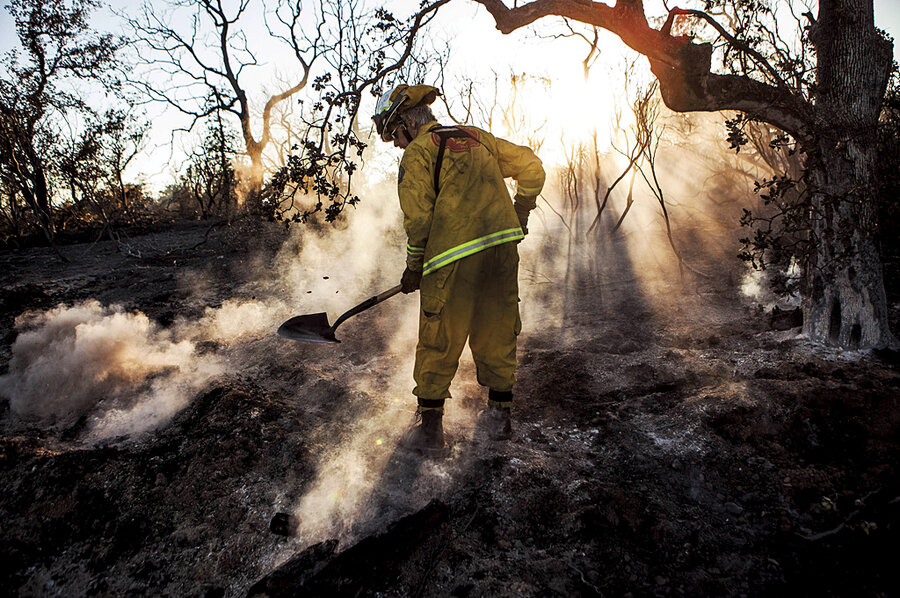Good Reads: From revamping fire policy, to gangs on Facebook, to middle-class causes
There is one thing that wildfire experts know for certain: Wildfires are unpredictable.
Fires have grown larger and more intense in the past 10 years, a result of a decades-long fire policy focused on extinguishing every forest fire as quickly as possible. This practice has created an overabundance of deadwood, turning “much of the American West into a tinderbox,” Paul Tullis writes in The New York Times Magazine.
Mr. Tullis gathered the latest research and methods fire experts have explored to solve the fire predictability conundrum. Researchers want to improve firefighters’ abilities to make better predictions in the field, especially when massive fires threaten lives and property. But even improved prediction models won’t prevent fires, he writes, arguing for a new fire policy that encourages managed burns in high-risk areas. “The way to make wildfires, and the people living near them, safer is by making peace with the idea that we need to let more of them burn longer,” he writes.
Preserving Haitian culture
Through her books, Edwidge Danticat invites readers into the homes of Haitian citizens and immigrants, giving vivid life to the struggles faced by generations in a country plagued by corruption and poverty. In an interview with Al Jazeera America, Ms. Danticat, who immigrated to the United States when she was 12 years old, explained how she also sees literature as key to preserving cultural identity and family heritage, especially in the wake of natural disasters such as Haiti’s 2010 earthquake.
“We need stories because when everything else is stripped away, that’s all we have left,” she said. “When the flood has come through and you lose all your belongings, when you have to leave your country at 24 hours’ notice, stories are all you have.... When I left Haiti, I don’t remember what was in my suitcase, I don’t remember what I brought with me. I do remember the stories I was told. I remember the life I had. That’s what I came with.”
Police track gangs on social media
Patrolling social media feeds has become a new beat for Chicago police officers as feuds between the city’s hundreds of gangs increasingly begin online before turning into violence in the streets.
For Wired magazine, Ben Austen visited the Chicago Police Department and some of Chicago’s toughest neighborhoods to see how YouTube, Facebook, Twitter, and Instagram have changed the way gangs operate and communicate. “We naturally associate criminal activity with secrecy, with conspiracies hatched in alleyways or back rooms,” Mr. Austen writes. “Today, though, foolish as it may be in practice, street gangs have adopted a level of transparency that might impress even the most fervent Silicon Valley futurist.”
The growth in online engagement among gang members presents new avenues for police work in Chicago and other large cities. Police catalog data about gang sets, members, locations, and event dates, so when they track real-time inflammatory comments, officers can step in before quarrels turn violent. “Give people social media and they’ll tell you what they’re about to do,” Austen writes.
Smart phones and violence in Congo
The rate and state of poverty in Congo is staggering, especially considering the country’s abundance of raw materials and its potential to become one of the continent’s wealthiest nations. But the mere existence of its mineral wealth has fueled a decades-long bitter conflict, creating a debilitating effect on the Congolese.
“It doesn’t make any sense, until you understand that militia-controlled mines in eastern Congo have been feeding raw materials into the world’s biggest electronics and jewelry companies and at the same time feeding chaos,” writes Jeffrey Gettleman in National Geographic. “Turns out your laptop – or camera or gaming system or gold necklace – may have a smidgen of Congo’s pain somewhere in it.”
Mr. Gettleman traced the source of Congo’s resource conflict to the days of King Leopold II of Belgium, who colonized Congo for ivory and rubber, and outlines the present-day melee of government, military, and rebel groups vying for control of the nation’s vast mineral deposits. Despite efforts by governments – and even many large technology companies – to guarantee conflict-free minerals in electronics, only 10 percent of Congo’s mines in its eastern provinces are “conflict free.”
Economic growth may save the planet
In a special report on biodiversity, The Economist links the salvation of endangered species to economic growth, particularly in developing nations where habitats are being cleared to make room for farmland. As people reach middle-class status, they can turn their attention, and resources, from meeting daily needs to other causes – such as environmentalism.
The article says that “thanks to a combination of environmental activism and economic growth the outlook for [endangered] species has improved, and that if growth continues, governments do more to regulate it and [environmentalists] embrace technological progress, there is a decent chance of man undoing the damage he has done during his short and bloody stay on the planet.”






